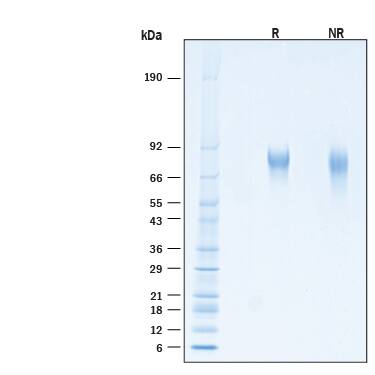Recombinant Human CD6 His-tag Protein, CF
R&D Systems, part of Bio-Techne | Catalog # 11288-CD

Key Product Details
Product Specifications
Source
His18-Glu398, with a C-terminal 6-His tag
Purity
Endotoxin Level
N-terminal Sequence Analysis
Predicted Molecular Mass
SDS-PAGE
Activity
When Recombinant Human ALCAM/CD166 Fc Chimera (Catalog # 7187-AL) is immobilized at 1 μg/mL (100 µL/well), Recombinant Human CD6 His-tag (Catalog # 11288-CD) binds with an ED50 of 30.0-300 ng/mL.
Scientific Data Images for Recombinant Human CD6 His-tag Protein, CF
Recombinant Human CD6 His-tag Protein Binding Activity.
When Recombinant Human ALCAM/CD166 Fc Chimera (7187-AL) is immobilized at 1 μg/mL (100 µL/well), Recombinant Human CD6 His-tag Protein (Catalog # 11288-CD) binds with an ED50 of 30.0-300 ng/mL.Recombinant Human CD6 His-tag Protein SDS-PAGE.
2 μg/lane of Recombinant Human CD6 His-tag Protein (Catalog # 11288-CD) was resolved with SDS-PAGE under reducing (R) and non-reducing (NR) conditions and visualized by Coomassie® Blue staining, showing bands at 75-85 kDa.Formulation, Preparation and Storage
11288-CD
| Formulation | Lyophilized from a 0.2 μm filtered solution in PBS with Trehalose. |
| Reconstitution | Reconstitute at 500 μg/mL in PBS. |
| Shipping | The product is shipped with polar packs. Upon receipt, store it immediately at the temperature recommended below. |
| Stability & Storage | Use a manual defrost freezer and avoid repeated freeze-thaw cycles.
|
Background: CD6
CD6 is a member of the group B scavenger receptor cysteine-rich (SRCR) superfamily. CD6 is a type I membrane glycoprotein and contains three extracellular SRCR domains. CD6 is expressed at low levels on immature thymocytes and at high levels on mature thymocytes. The majority of peripheral blood T cells, a subset of B cells, and a subset of neuronal cells express CD6. CD6 is a 668 amino acid protein with a 24 amino acid predicted signal sequence, a 374 amino acid extracellular domain, and a 244 amino acid transmembrane region. The 626 amino acid murine homolog has also been identified. The human and murine proteins share 70% amino acid identity over their full-lengths. The role of CD6 has not been fully elucidated. However, it appears to play a role as both a co-stimulatory molecule in T cell activation and as an adhesion receptor. Studies demonstrating a mitogenic effect for T cells with some CD6 specific monoclonal antibodies, in conjunction with either accessory cells or PMA and anti-CD2 mAb, support the concept of CD6 as a co-stimulatory molecule. Anti-CD6 monoclonal antibody has been used as an immunosuppressive agent for patients undergoing kidney or bone marrow allograft rejection. It has also been used to remove CD6+ T cells from donor bone marrow prior to allogeneic bone marrow transplantation. Other studies have demonstrated an adhesive role for CD6, it has been demonstrated to bind the activated leukocyte cell adhesion molecule (ALCAM, CD166). CD6/ALCAM interactions have been postulated to play a role in thymocyte development. The presence of ALCAM on neuronal cells may provide a mechanism of interaction between CD6+ T cells and ALCAM+ neuronal cells. Phosphorylation of the CD6 molecule appears to play a role in CD6-mediated signal transduction. Serine and threonine residues become hyperphosphorylated and tyrosine residues become phosphorylated when T cells are activated with anti-CD6 mAb in conjunction with PMA, anti-CD2, or anti-CD3 mAb. The CD6 intracellular domain contains regions that can interact with SH2 or SH3 containing proteins. However, the signaling pathways have not been elucidated.
References
- Gangemi, R.M. et al. (1989) J. Immunol. 143:2439.
- Aruffo, A. et al. (1991) J. Exp. Med. 174:949.
- Swack, J.A. et al. (1991) J. Biol. Chem. 266:7137.
- Robinson, W.H. et al. (1995) Eur. J. Immunol. 25:2765.
- Whitney, G. et al. (1995) Mol. Immunol. 32:89.
- Starling, G.C. et al. (1996) Eur. J. Immunol. 26:738.
- Degen, W.G. et al. (1998) Am. J. Pathol. 152:805.
- Swack, J.A. et al. (1989) Mol. Immunol. 26:1037.
- Pawelec, G. and H.J. Buhring (1991) Hum. Immunol. 31:165.
- Osorio, L.M. et al. (1995) Cell Immunol. 166:44.
- Robinson, W.H. et al. (1995) J. Immunol. 155:4739.
- Singer, N.G. et al. (1996) Immunology 88:537.
- Aruffo, A. et al. (1997) Immunol. Today 18:498.
Alternate Names
Gene Symbol
UniProt
Additional CD6 Products
Product Documents for Recombinant Human CD6 His-tag Protein, CF
Product Specific Notices for Recombinant Human CD6 His-tag Protein, CF
For research use only

